Two weeks ago, hundreds of scientists, students, and scientifically-inclined laymen gathered at Cedarville University to attend the ninth International Conference on Creationism (ICC). It had been five years since the previous ICC, and everyone was eager to learn about new cutting edge creation research or present some research of their own, become reacquainted with old friends, or even make new ones.
Several of us from New Creation—Sara, Christian, Peter, Jake, and Hannah—were able to travel from across the United States to Cedarville to attend the conference. This was a first for some of us, as most of us had never attended ICC before. For some of us, this was our first scientific conference ever. What was it like for five STEM students at ICC 2023?
What Was It Like Attending the International Conference on Creationism?

One of the best parts of attending the ICC is the ability to rub shoulders with creation researchers. There were lots of familiar faces, including the scientists who starred in Is Genesis History?. Some of us stayed up into the wee hours of the morning chatting about floating forests with Dr. Kurt Wise. Unlike other creation conferences, the ICC is international, bringing scientists together from around the world. Attendees came from the United Kingdom, the Netherlands, and even Australia.
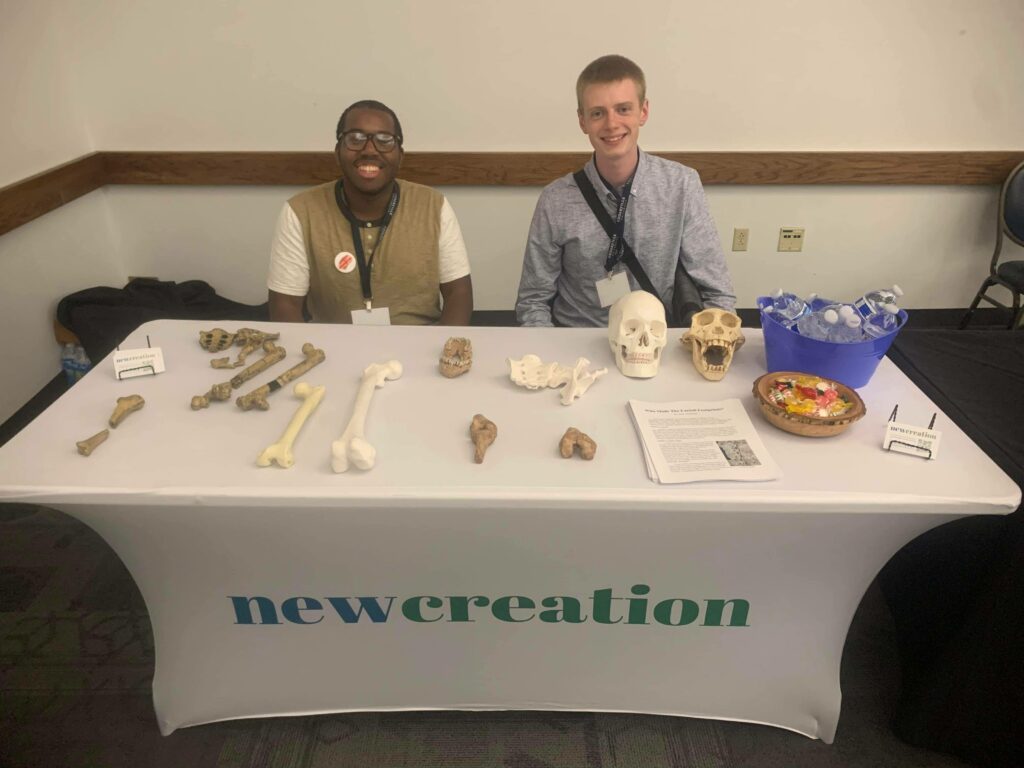
New Creation was represented by a booth at the conference. We were able to engage with fellow creationists and share printouts of some of our articles. Next to our table was a beautiful display of fossils and miniature models presented by Chad Arment. Other young-earth creationist organizations also had booths presenting information about them and displaying business cards, pamphlets, other reading material, and props. We had fun stopping by the Let’s Talk Creation booth, getting photos with the giant cutout heads of the hosts, and listening to the interviews taking place there.
Many attendees and presenters were college-aged students. While we cannot compare the demographics this year to past ICC’s, we have heard from long-time participants that the number of young, young-earth creationist scholars has increased greatly since ICC’s inception.
New Features at ICC 2023
ICC 2023 was different in many ways to previous years. The biggest difference was the location; Cedarville University hosted ICC for the first time. The new organizers did a wonderful job preparing and running the conference. There were also some new ways to present research this time. In previous years, presentations were only summarizing full-length technical papers. This time around, there were presentations summarizing research abstracts.

In the context of science conferences, a paper is a detailed, comprehensive document that provides an in-depth account of the research completed. They include a thorough explanation of the study’s background, methods, results, analysis, and conclusions. On the other hand, abstracts are concise summaries of a research study or presentation, typically limited to a few hundred words. They highlight the key objectives, methods, results, and conclusions of the work. An abstract allows conference attendees to quickly understand the essence of the research without having to read a full-length paper. Papers are usually much longer and more extensive than abstracts, often ranging from several to several dozen pages in length. Abstracts provide a great way for presenting preliminary research that perhaps is not to the point where a full-length paper is necessary. An abstracts also allow for feedback from other scientists before its author does more work.
This was also the first ICC to have research posters. Similar to abstracts, they often include pictures and diagrams relevant to the research described. One or more researchers involved in the project will often stand near their poster to answer questions.
A Brief Summary of Topics at the Conference
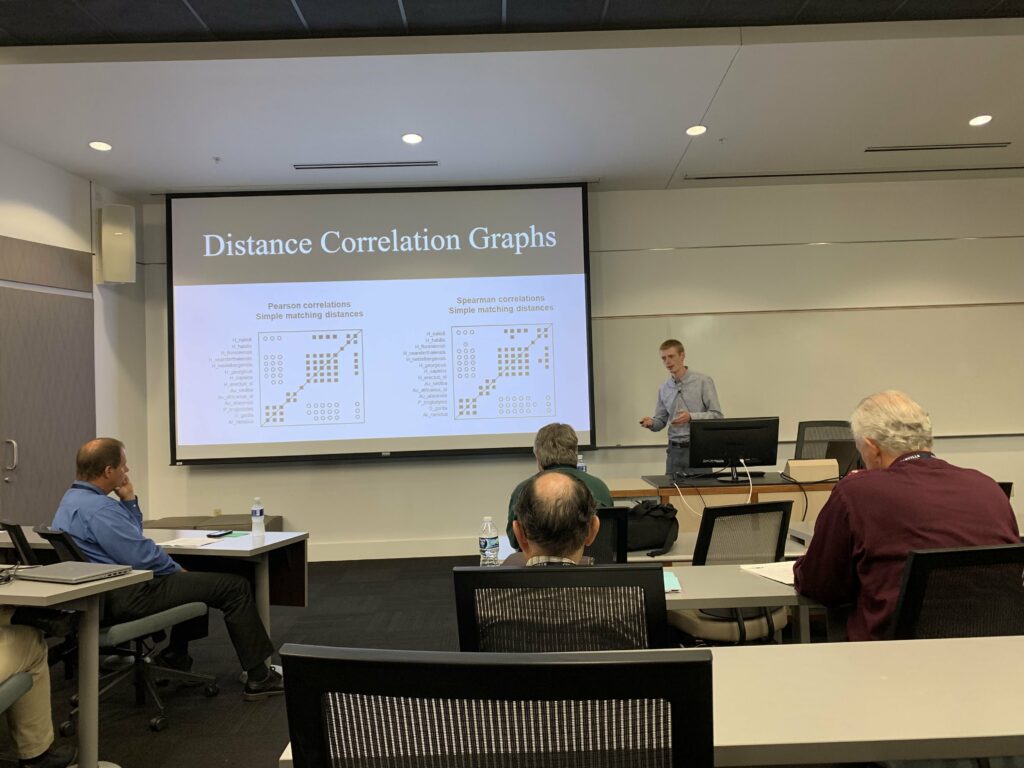
With dozens of presentations given, an in-depth summarization of each one would be impractical. This is especially the case since, even with five of us, there were far too many lectures for us to attend all of them. Nevertheless, we can provide a brief summary of some of the presentations given at ICC 2023.
Testing the Order of the Fossil Record: Preliminary Observations On Stratigraphic-Clade Congruence and Its Implications for Models of Evolution and Creation
Research by Todd Wood, Paul Garner, and Kathryn McGuire
Evolutionists often cite the order of the fossil record as evidence for evolution. What they mean by this is that the general order of the evolution of vertebrate classes (fish – amphibians – reptiles – birds – mammals) appears in the fossil record in the exact order that evolution predicts. Today, thanks to the rise of genetics, evolutionists have a far more detailed understanding of the order in which species (supposedly) evolved. Their model is organized in family trees called “phylogenies,” which are meant to show how genetically related different species are to each other. Evolutionists have constructed lots of phylogenies outlining the evolution of different kinds of animals.
This paper used a statistical correlation test to compare published phylogenies to the observed order of the fossil record. The purpose was to see if the evolutionary predictions (based on genetics) were accurate. The results were not great for the evolutionary model. Though ~75% of the total phylogenies correlate statistically with the fossil record, the more detailed phylogenies are only ~25% correlated. The paper concludes that, while the fossil record supports the evolutionary predictions concerning general vertebrate groups, it does not support the majority of more specific phylogenies—including those of most invertebrates.
What Biostratigraphic Continuity Suggests About Earth History
Research by Kurt Wise and Donna Richardson
Kurt Wise gave a fascinating talk on fossils and their implications for flood boundaries. His research utilized the Paleobiology Database, which contains records of the geographic location of a fossil and its identity. He used this data to identify if a particular species was found in successive layers in a localized area. Wise noted that the end of the Flood should leave behind a distinctive pattern in the fossil record. The species which died in the Flood should no longer appear in the next layers. It is incredibly unlikely that animals which survived the Flood would go back and live in the same place as their ancestors did.
Wise concluded that the Cretaceous/Paleogene boundary probably represents the end of the Flood. Researchers find relatively few species on both sides of the boundary in the same geographic location. However, this spelled problems for the Neogene/Quaternary boundary proposed by some as the end of the Flood. Many species were found to cross this boundary.
Human History: From Adam to Abraham
Research by Marcus Ross, Todd Wood, and Peter Brummel
In this talk, Marcus Ross presented a general model of paleoanthropology from a young earth perspective. It began by discussing the usefulness of cultural evidence as an indication of humanity. He detailed six criteria: fire use, the creation of complex tools, art, care for the elderly, burial, and complex dispersion. Some hominins, like Neanderthals, display all of these behaviors, strongly indicating that they are human.
The paper goes on to point out that these human fossils must be post-Fall, since they themselves are evidence of death. They also make the case that all known hominin fossils are post-flood. Neanderthals, for example, lived in caves carved in flood rock. So, they must have lived after the flood. They make the case that these fossils are the remains of people who spread out following the dispersion from Babel.
How Often Do Radioisotope Ages Agree? A Preliminary Study Of 29,000 Radioisotope Ages In The USGS National Geochronological Database
Research by Paul Garner, Micah Beachy, and Benjamin Kinard
Using a public geology database containing tens of thousands of records, this paper compares radioisotope dates across different dating methods. Garner et al. considered two dates for a rock concordant if their standard error bars overlapped. If those margins of error did not overlap, however, they considered the rocks discordant.
After discarding data in which only one date was available, Paul Garner and his research students Micah Beachy and Benjamin Kinard had over 18,000 unique records and slightly over 29,000 distinct ages to work with. They found that different dating methods were concordant with each other 64% of the time. Rocks with three dates had a low concordance score of 39% (out of 34 records) and the U-Th-Pb dating technique matched other dating methods 57% of the time.
More research is needed since the database requires clean up, but preliminary results suggest that different radioisotope dating techniques do not consistently yield concordant dates. This is further evidence that the ancient “ages” obtained from these dating methods may not accurately reflect the amount of time that passed since the rocks themselves formed.
Shoreline Transgressive Terraces: Tufa-Encrusted Landforms Indicate Rapid Filling and Failure Of Hopi Lake, Western Bidahochi Basin, Northeastern Arizona
Research by Steven Austin, Edmond Holroyd, Thomas Folks, and Nate Loper

Hopi Lake is a large body of water that some researchers hypothesize catastrophically overspilled and carved out the Grand Canyon. This hypothesis has experienced much criticism from many old-earth geologists and some young-earth creationists alike. They argue that there is no evidence for Hopi Lake’s existence, or at the very least that it did not contain enough water to carve the Grand Canyon.
In their continued research of this lake, legendary geologist Dr. Steve Austin and his team present more evidence not only that the lake existed, but that it rapidly filled with lots of water before catastrophic spillage. Dr. Austin, who presented this talk, described the ridges as ancient shorelines that documented the successive, but rapid, filling of the lake and its subsequent emptying. He also lamented the young-earth creationists who had claimed there was no evidence for Hopi Lake. Whether Dr. Austin knew it or not, at least one of them was sitting in the audience and was spotted by this New Creation team member.
The Role of and Limits on Uniformitarian Principles in Creationist Sedimentology Research
Research by Sarah Maithel
Uniformitarianism is the idea that the processes we see happening today can accurately explain how geological features formed in the distant past. It has been a fundamental concept in geology since the time of James Hutton, Archibald Geikie, and Charles Lyell. However, some geologists criticize this idea because they believe that past geological processes might not have occurred at the same rate as they do today.
In this presentation, Sarah Maithel pointed out that although uniformitarianism is commonly used, it is less relied upon in young-earth geology. This is because catastrophic geological events in modern times can be helpful in understanding how ancient catastrophic events created certain rock formations, like the Great Flood.
While this approach is valuable, it has limitations, as some geological features cannot be fully explained by modern analogues. For instance, researchers often think the Coconino Sandstone formed in a desert environment similar to today’s Sahara. However, young-earth geologists argue that the evidence suggests it formed underwater, instead. Even though the data supports an underwater origin, modern underwater sand dunes don’t provide a perfect analogy for this particular case.
To address such challenges, Maithel suggests that geologists should think beyond the limitations of modern analogues and come up with innovative ways to interpret geological evidence.
A Creationist Model of Dinosaur Biogeography
Research by Marc Surtees
I (Christian) arrived just on time for this presentation because I figured I would have no trouble finding seating. I assumed this because the legend, Dr. John Baumgardner, was giving a lecture at the exact same time. Imagine my surprise when I found that the room was just about full, and I only just managed to find a seat before it became “standing room only.”
In this talk, Dr. Surtees argued that the distribution and presence of dinosaur footprints suggests that the dinosaur fossil record formed after the Flood, and not during it as most young-earth creationists believe. This talk was brief, as the presenter wanted to ensure that there would be plenty of time for audience questions at the end, which I greatly appreciated.
I think this presentation illustrated an important point, in that young-earth geologists have developed very complex models with explanatory power throughout the Paleozoic strata. I think we also have a fairly good post-Flood understanding of the Cenozoic. But there does not seem to be a very well-rounded understanding of the Mesozoic. If it formed during the Flood, then more work needs to be done to explain how there can be evidence of mobile dinosaurs on sedimentary deposits formed earlier in the Flood. If it formed after the Flood, more work needs to be done to explain how they were formed in a post-Flood context. All in all, a very intriguing presentation and a lively Q&A session afterward!
Hominin Baraminology Reconsidered With Postcranial Characters
Research by Todd Wood and Peter Brummel
Our very own Peter Brummel gave this talk, and detailed the latest findings about the human kind. Most baraminological studies of humans have focused almost entirely on features of the skull and teeth. However, we recognize that the rest of the skeleton also plays an important role in distinguishing us from animals.
Wood and Brummel set out to create a more comprehensive data matrix by which they could identify anatomical differences throughout the skeleton. They documented hundreds of different features in the bones of modern people, chimps, gorillas, and a wide variety of hominin fossils. To collect this data, they traveled to museums to evaluate original fossils, collected high quality casts, 3D printed replicas of the bones, and read through much of the literature.
Cluster analysis of the data revealed a fairly consistent pattern. All of the species within the genus Homo seemed to be continuous with one another. This supports the conclusion that they are all humans, and thus descendants of Adam and Eve. Australopithecines, like the famous Lucy fossil, seem to have belonged to a separate created kind. Interestingly, they were probably unrelated to chimps and gorillas.
How Should Creationists Respond to Dark Matter / Dark Energy?
Research by Danny Faulkner
In this presentation, Dr. Danny Faulkner gave an overview of discoveries in the 20th century that led to the widespread acceptance of dark matter/energy. Several independent lines of evidence contributed to the proposal of dark matter. Meanwhile, two teams of astronomers working independently discovered the evidence for dark energy. Neither dark matter nor dark energy are simply invented constructs of Big Bang cosmology. They both derive from real phenomena that any coherent cosmology needs to reckon with.
So what do recent creationists do with dark matter and dark energy? One common approach has been to see the discrepancy in mass measurements as an indication of instability, and thus youth, in the universe. An issue with this approach is the fact that it contradicts the design argument of stability in the cosmos. Alternatively, some have suggested a form of Modified Newtonian Dynamics (MOND) might explain the evidence for dark matter. However, if dark matter is only an effect of MOND, then all galaxies ought to show the same amount of dark matter, which is not the case.
Ultimately, dark matter and dark energy are concepts derived from real data that need to be accounted for in creationist cosmologies.
The State of Theology and Creation Science
Presentation by William Barrick
In previous years, ICC has included evening plenary presentations, open to the public, from invited creation speakers. This time around, the format was a little different. Each evening there was a series of three to four 30-minute presentations from invited researchers. Each speaker gave a summary of the current state of their discipline in creationism.
Dr. William Barrick, professor of Biblical Hebrew and secretary of the Creation Theology Society, gave the opening plenary presentation Sunday night. He spoke on where the relationship of theology and creation science is now, and where it ought to be. “Theology used to be known as ‘the queen of the sciences,’” he reminded us. He argued that, as creation scientists, we need to put theology back in that rightful place. Young-earth creationists have been very vocal against careless exegesis of Scripture by theistic evolutionists and old-earth creationists. However, Dr. Barrick points out we have been just as careless with our own interpretation and application of Scripture in some areas.
What can we, as a scientific community, do to reinstate theology as the “queen of the sciences”? First, we can listen to experts trained in biblical studies from outside of scientific disciplines. Listen especially to those who affirm the historical reality of Genesis. Second, we can involve these experts in the peer-review of creationist publications. Third, we can promote interdisciplinary research between the scientific disciplines and theology. The Creation Theology Society in particular exists to provide a platform and a community to help us achieve these goals.
We will be covering the research presented in these and other talks in articles of their own over the coming months. Stay tuned!
When We Disagree
I (Christian) once heard a skeptic of young-earth creationism describe ICC as a place where critical, scientific peer-review could not occur because everyone is already in full agreement and simply pats each other on the back. This person clearly has never been to an ICC.
While we agree on the core tenants of young-earth creationism, there is plenty of disagreement. On the first night, I got caught in the middle of not one, but two disagreements between practicing scientists! These types of discussions can be fruitful for scientific progress. Opposing sides can challenge the other for ways they can modify their position to accommodate more data. One of my favorite displays of these sorts of interactions happens during panel discussions.
A panel discussion at a science conference brings together a group of experts in a specific field. Here, they share their insights, knowledge, and perspective with each other and the conference attendees. Each panelist gives a brief introduction or presentation on their area of expertise related to the panel theme. After the initial presentations, the audience poses questions to the panelists, encouraging the exchange of ideas, debate, and discussion of various aspects of the topic at hand.
Panel discussions are a valuable part of science conferences. They allow for an in-depth exploration of complex topics and encourage collaboration and networking among professionals in the field. They also offer conference attendees the opportunity to engage directly with experts and ask related questions.
ICC held three three panel discussions held this year, all very interesting in their own way.
Feathered Dinosaurs: Implications for Creationism
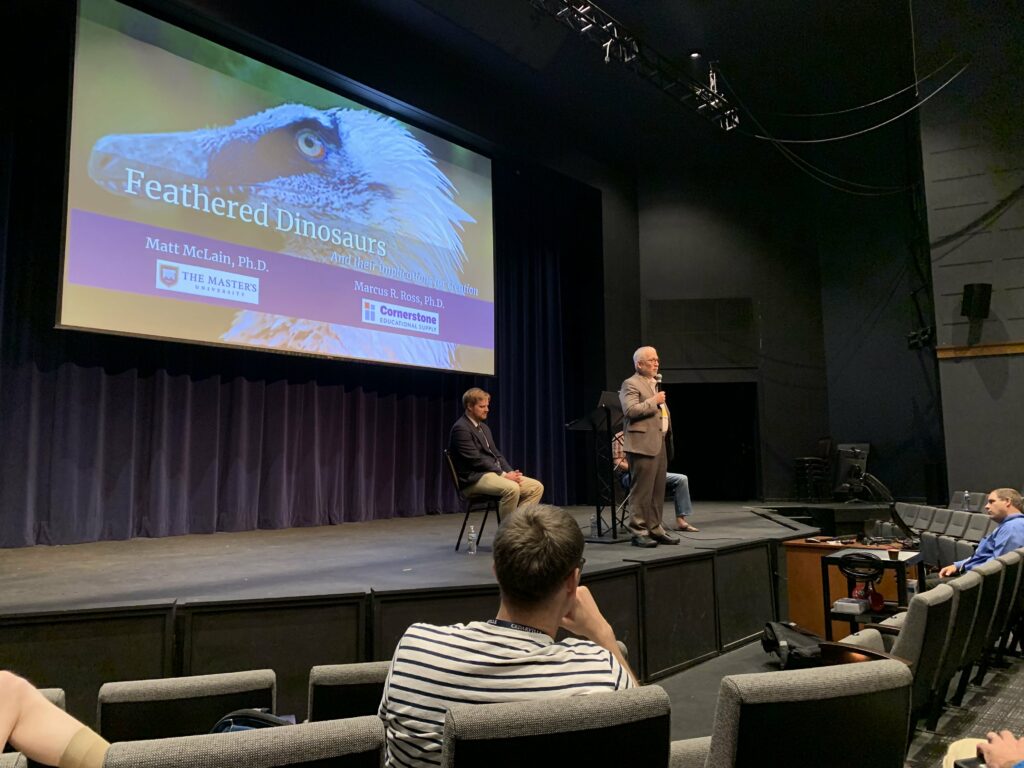
This panel discussion served as a sort of response to the infamous McLain et al. paper on feathered dinosaurs. The audience of that ICC 2018 presentation and its associated paper did not receive it terribly well.
This year, Dr. Matt McLain returned alongside fellow paleontologist Dr. Marcus Ross. Together, they gave four short presentations, each followed by a question and answer period. They discussed the definitions used to classify dinosaurs and birds, the nature of feathers, and the evidence of feathers in certain non-avian dinosaur fossils. Finally, they explored the creationist research on the topic, and the implications of feathered dinosaurs for the creation model.
The audience seemed to receive the panel discussion well, and had thought-provoking questions. Hopefully gestures such as this will lead to a wider acceptance of feathered dinosaurs among creationists. At the very least, it may lead to less resistance against the idea.
Pre-Flood/Post-Flood Boundaries
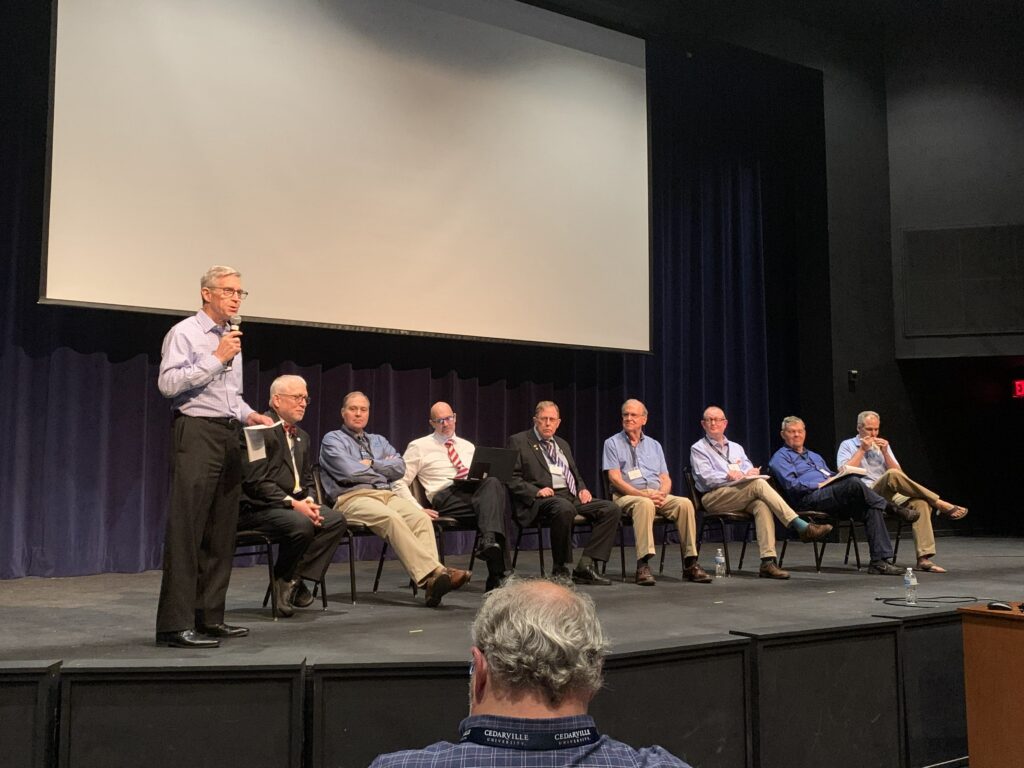
The geologic record’s formation during Noah’s global Flood is a topic of debate among scientists. Some argue that the Flood accounts for most animal fossil-bearing rock layers predating the Ice Age. Others suggest that the Flood formed a smaller portion of the rock record. A few researchers hold positions in between these two extremes.. This four-hour forum aimed to bring advocates of various Flood models together. Participants included Dr. John Baumgardner, Dr. Tim Clarey, Dr. Ken Coulson, Harry Dickens, Paul Garner, Dr. Michael Oard, and Dr. Marcus Ross.
Unfortunately, time constraints limited free-flowing discussions among panelists. Each presented their evidence favoring their position, helping identify potential research projects to further our understanding of the Flood. One interesting proposal discussed the breakup of Earth’s continents during the Flood. Geological evidence suggests the continents were once united as a supercontinent. Dr. Baumgardner highlighted that known physics suggests continental movements could only occur very fast (as during the Flood) or very slowly (like today). Accordingly, moderate speeds seemingly required by lower Flood boundaries are highly implausible.
In a brief 10-minute discussion, the idea surfaced that radiometric ages from deep seafloors might differ from continental rocks. This would imply less movement of continents in the Cenozoic era than conventionally believed. This suggestion aligns with the work of Garner’s team on radioisotope dating, presented earlier in the conference.
Resolving the mystery of the Flood’s extent in the geologic record is crucial. It profoundly impacts our comprehension of post-Flood climate, human and animal migration, the diversification of created kinds, Earth’s crustal movements, sedimentary layer formation, and our ability to predict future discoveries. While the forum facilitated presentations of different Flood models, further research is needed to shed light on this complex geological event.
Biogeography in the Post-Flood Landscape
Researcher Chad Arment held an interactive forum consisting of a round-table discussion on post-Flood biogeographical patterns in dispersal and diversification. In other words, where we find land-dependent animals today and how they got there from the Ark. Of particular interest were dispersal mechanisms (like land bridges and rafting) and how animals journeyed to Australia and South America.
This forum hoped to encourage and inspire continued research in this rather sparsely addressed field of creation biology. Arment also hopes to stimulate networking of creation biologists and paleontologists. He wants to elicit discussion of projects that might be currently in progress or under consideration.
As we have come to expect with panel discussion Q&A’s, there was a lively exchange of ideas and questions. While technically not the seminar’s topic, some attention was given to whether the Mesozoic could be considered Flood or post-Flood. If post-Flood, it was argued that the breakup of Pangaea could help explain how living things dispersed around the world. This explanation would not necessitate them crossing oceans in between the various continents.
There was an equally intriguing discussion between Arment and various members of the audience about how marsupials migrated to Australia after the Flood. Arment pointed out that the conventional creationist view is implausible. This view holds that marsupials traveled from the mountains of Ararat to Australia via the Sundaland land bridge in southeast Asia. This land bridge, however, never went all the way to Australia. Most animals and plants exist on one side of the divide, but not the other. His alternative hypothesis proposes that marsupials migrated across the Atlantic Ocean, down through Antarctica, and finally north again into Australia.
Conclusion
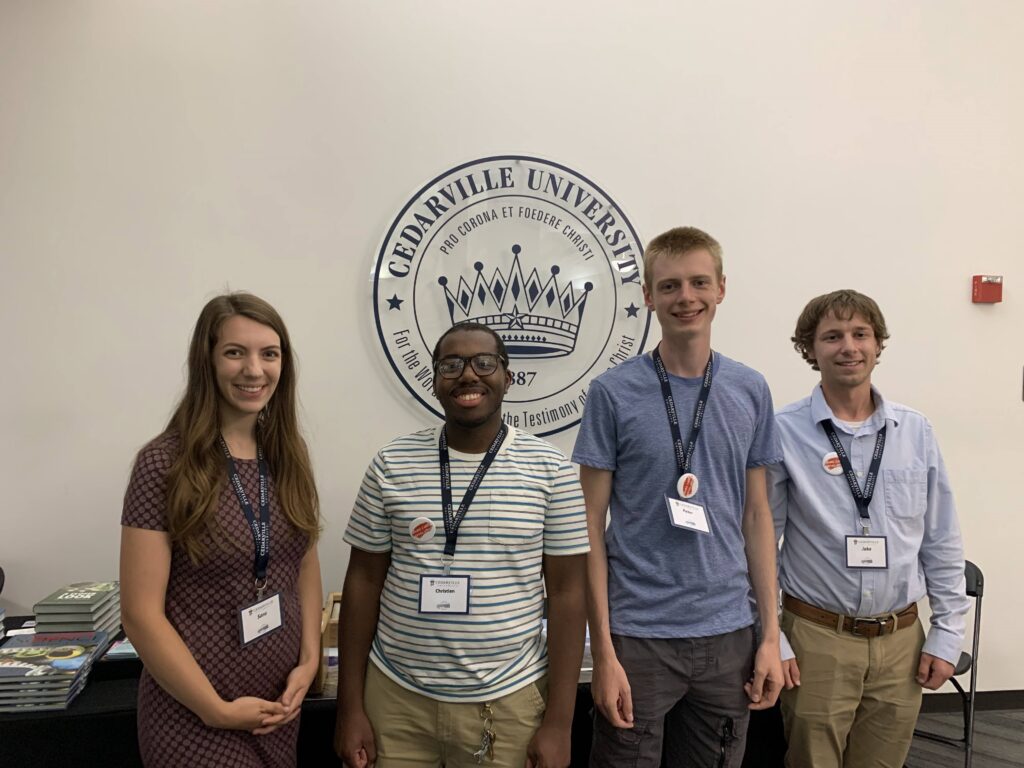
In principle, we went to ICC to see the new and exciting research happening in the world of creation science. But our experience was much more than that. We got to meet scientists and other like-minded individuals, many of whom were students like ourselves. One of our biggest takeaways from ICC was that this was more than using science to destroy conventional unbiblical views on origins. Presenters and attendees came here with a goal to edify our Creator and to understand Him through the world He created and its dynamic history.

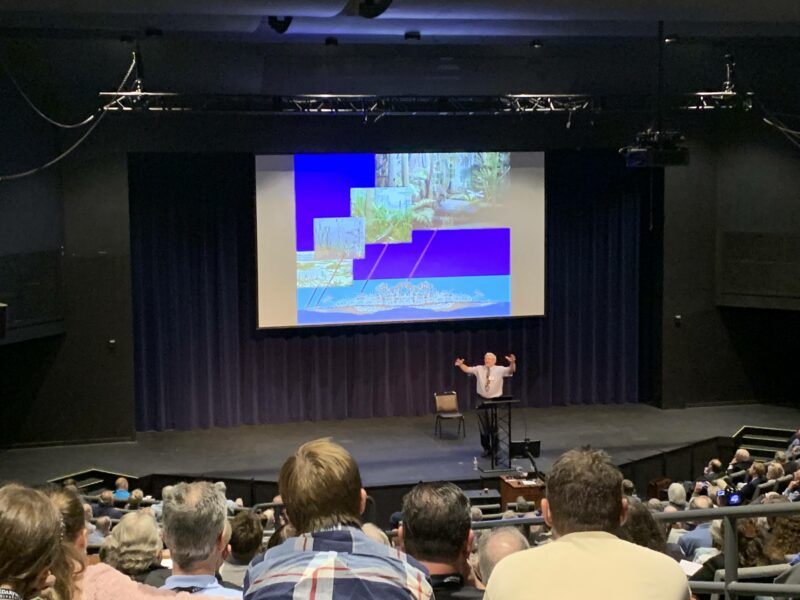




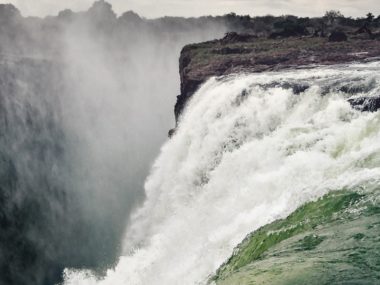





Thank you for this summary of ICC 2023! I wish I could have been there myself but I am glad that you all got to have a great experience. God Bless!